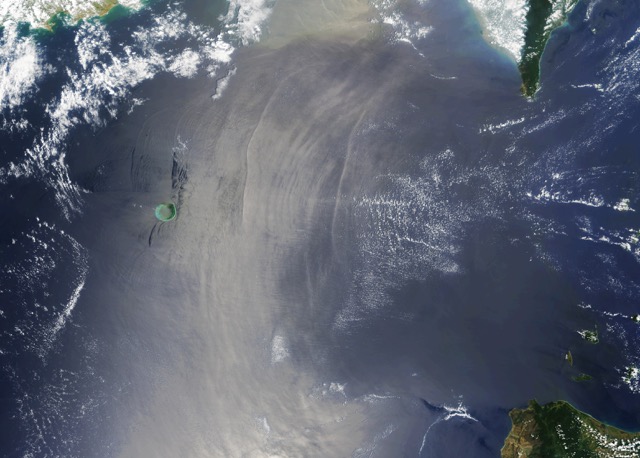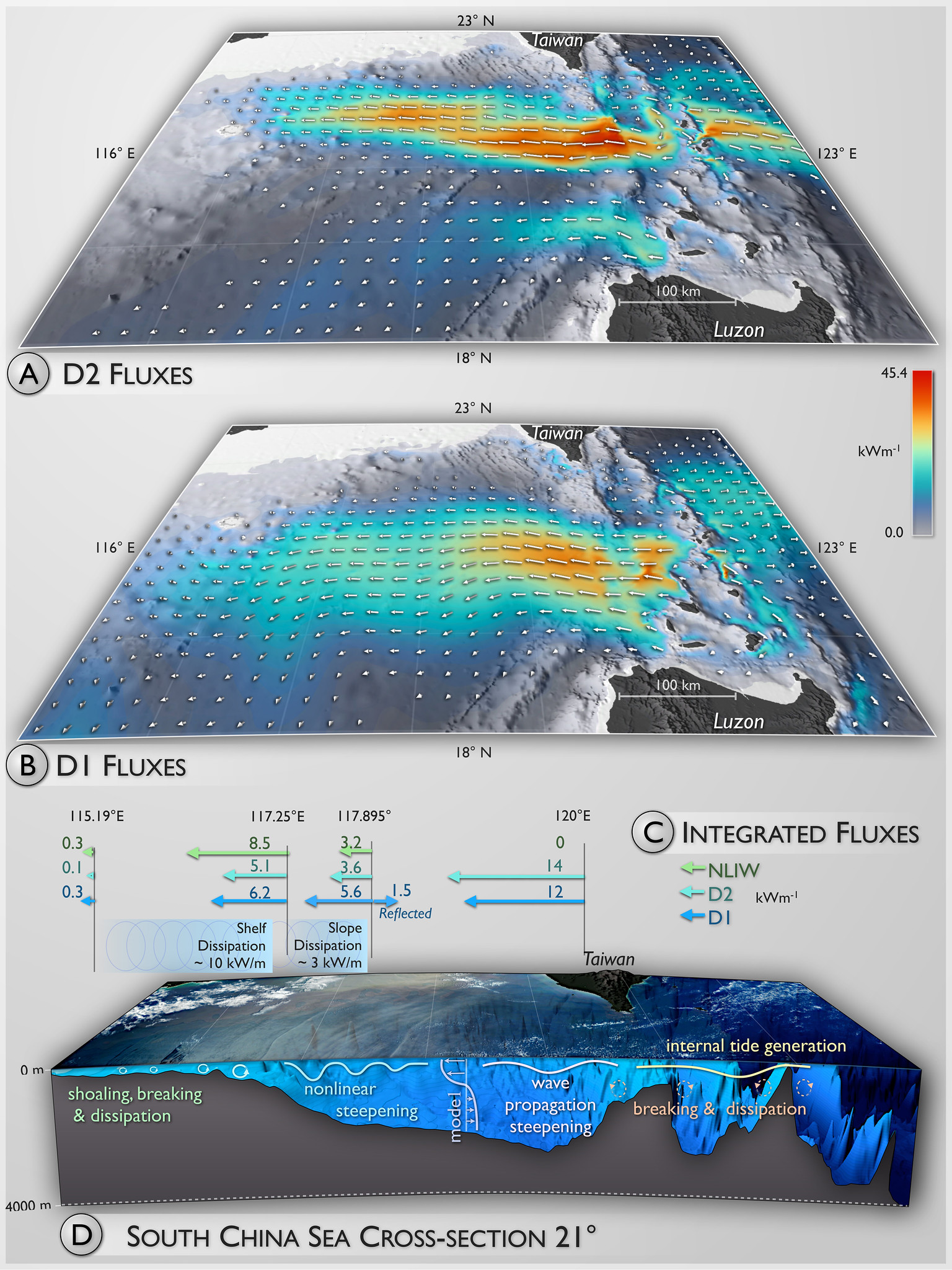This animation shows density layers in the South China Sea being perturbed by the regular back-and-forth tidal flow through the Luzon Strait.
These leads to large amplitude internal waves (shown in red underwater, and in white when seen from above), being radiated west to the Chinese continental shelf.
Once a day, a wave as tall as the Empire State Building and as much as a hundred miles wide forms in the waters between Taiwan and the Philippines and rolls across the South China Sea – but on the surface, it is hardly noticed.
Simulation
of internal waves of the South China Sea by Dr. Harper Simmons of the
University of Alaska Fairbanks using Arctic Region Supercomputer Center
High Performance Computing resources. Visualization by the University of
Washington Center for Environmental Visualization).
These daily monstrosities are called "internal waves" because they are beneath the ocean surface and though scientists have known about them for years, they weren't really sure how significant they were because they had never been fully tracked from cradle to grave.
Surprisingly, internal waves can sometimes be seen clearly in satellite imagery (like in the above image of the Luzon Strait).
This is because the internal waves create alternating rough and smooth regions of the ocean that align with the crest of the internal wave.
Sunlight reflects the smooth sections, appearing as white arcs, while the rough sections stay dark.
But a new study, published this week in Nature Research Letter, documents what happens to internal waves at the end of their journey and outlines their critical role in global climate.
The international research project was funded by the Office of Naval Research and the Taiwan National Science Council.
"Ultimately, they are what mixes heat throughout the ocean," said Jonathan Nash, an Oregon State University oceanographer and co-author on the study. "
Without them, the ocean would be a much different place.
It would be significantly more stratified – the surface waters would be much warmer and the deep abyss colder.
"It's like stirring cream into your coffee," he added. "Internal waves are the ocean's spoon."
Internal waves help move a tremendous amount of energy from Luzon Strait across the South China Sea, but until this project, scientists didn't know what became of that energy.
As it turns out, it's a rather complicated picture.
A large fraction of energy dissipates when the wave gets steep and breaks on the deep slopes off China and Vietnam, much like breakers on the beach.
Researchers from the
Office of Naval Research's multi-institutional Internal Waves In Straits
Experiment (IWISE) -- including from Princeton University -- have
published the first 'cradle-to-grave' model of internal waves, which are
subsurface ocean displacements recognized as essential to the
distribution of nutrients and heat. The researchers modeled the internal
waves that move through the Luzon Strait between southern Taiwan and
the Philippine island of Luzon. Credit: Maarten Buijsman, University of
Southern Mississippi
Read more at: http://phys.org/news/2015-05-giant-internal-climate.html#jCp
Read more at: http://phys.org/news/2015-05-giant-internal-climate.html#jCp
Researchers from the Office of Naval Research's multi-institutional Internal Waves In Straits Experiment (IWISE) -- including from Princeton University -- have published the first 'cradle-to-grave' model of internal waves, which are subsurface ocean displacements recognized as essential to the distribution of nutrients and heat.
The researchers modeled the internal waves that move through the Luzon Strait between southern Taiwan and the Philippine island of Luzon.
Credit: Maarten Buijsman, University of Southern Mississippi
But part of the energy remains, with waves reflecting from the coast and rebounding back into the ocean in different directions.
The internal waves are caused by strong tides flowing over the topography, said Nash, who is in OSU's College of Earth, Ocean, and Atmospheric Sciences.
The waves originating in Luzon Strait are the largest in the world, based on the region's tidal flow and topography.
A key factor is the depth at which the warm- and cold-water layers of the ocean meet – at about 1,000 meters.
The waves can get as high as 500 meters tall and 100-200 kilometers wide before steepening.
"You can actually see them from satellite images," Nash said.
"They will form little waves at the ocean surface, and you see the surface convergences piling up flotsam and jetsam as the internal wave sucks the water down. They move about 2-3 meters a second."
The waves also have important global implications.
"These are not small effects," Nash said.
This new study, which was part of a huge international collaboration involving OSU researchers Nash and James Moum – as well as 40 others from around the world – is the first to document the complete life cycle of these huge undersea waves.
The complexity of the Luzon Strait's two-ridge system was not previously known.
The Princeton researchers' simulations showed that the two ridges of the Luzon Strait greatly amplify the size and energy of the waves, well beyond the sum of what the two ridges would generate separately.
The simulation above of the tide moving over the second, or western, ridge shows that the tidally-driven flow reaches a high velocity (top) as it moves down the slope (left to right), creating a large wave in density (black lines) with concentrated turbulent energy dissipation (bottom).
As the tide moves back over the ridge, the turbulence is swept away.
For both the velocity and energy dissipation panels, the color scale indicates the greatest velocity or energy (red) to the least amount (blue).
Credit: Image by Maarten Buijsman, University of Southern Mississippi
The Princeton researchers' simulations showed that the two ridges of the Luzon Strait greatly amplify the size and energy of the waves, well beyond the sum of what the two ridges would generate separately.
The simulation above of the tide moving over the second, or western, ridge shows that the tidally-driven flow reaches a high velocity (top) as it moves down the slope (left to right), creating a large wave in density (black lines) with concentrated turbulent energy dissipation (bottom).
As the tide moves back over the ridge, the turbulence is swept away.
For both the velocity and energy dissipation panels, the color scale indicates the greatest velocity or energy (red) to the least amount (blue).
Credit: Image by Maarten Buijsman, University of Southern Mississippi
Links :



No comments:
Post a Comment